Energy Supply Chains in the Digital Age: A Review of Current Research and Trends
Abstract
:1. Introduction
- Q1: What are the main research trends regarding the digitisation of the energy supply chain?
- Q2: Which digital technologies are most frequently described in connection with the digitisation of the energy supply chain?
- Q3: How has digital transformation affected the security of the energy supply chain?
- Q4: As with other sectors of the economy, did the COVID-19 pandemic initiate research into the digitisation of the energy supply chain?
- Q5: How does digital transformation affect the sustainability of the energy supply chain?
2. Theoretical Background
3. Methodology
4. Bibliometric Analysis
5. Results
5.1. Cybersecurity
5.2. Digital Transformation as a Development Trend and Improvement in the ESC
5.3. Smart Grid
5.4. Technologies Used to Improve ESC
- Blockchain
- In [59], three main challenges for applying blockchain are described, and a developed, decentralised peer-to-peer (P2P) energy trading platform is presented.
- According to [60], the widespread use of blockchain can streamline ESC participants’ handling of the many digital procedures, operational tasks, production schedules, and supply chains that affect how the digital well programme and schedules are created.
- In [61], a blockchain-as-a-service is presented as an evolving platform service. Its popularity could contribute to developing modern energy systems such as battery energy storage systems (BESSs).
- The research presented in [62] proposes a solution that offers the structure and architecture of a high-level proactive supply chain system based on blockchain and the Internet of Things. The effectiveness of blockchain technology has been confirmed in automating processes in the automotive supply chain, reducing fragmentation and increasing trust between suppliers.
- The research presented in [63] demonstrates the need to involve government bodies, energy companies, and consumers in adopting blockchain to operate ESCs.
- The results of the research presented in [64] indicate that blockchain-based applications should be used primarily to integrate IoT devices into the power grid, manage e-mobility infrastructure, automate billing and direct payments, and issue electricity origin certificates.
- Keivanpour et al. [65] presented the application of blockchain in improving the operation of offshore wind farm systems.
- Internet of Things (IoT)
- The research presented in [62] proposed a solution for the structure and architecture of a high-level proactive supply chain system based on blockchain and the IoT. The IoT was used to track the performance of power plant components, ensuring timely maintenance.
- Dobrowolski [42] researched the risks of using the IoT to support the energy supply chain.
- In [66], the authors assessed the potential of using the IoT to improve the efficiency of the operation of the renewable energy supply chain
- Artificial intelligence
- Digital platforms
- A holistic view of digital platforms in the energy sector, as well as their revenue models, typologies, and regulatory options, is presented in [69].
- Haouel [70] describes the main trends in the digital transformation of oil and gas supply chains, including using platforms that provide the data needed to collaborate with suppliers.
- In their publication, Coppolino et al. [71] explain the necessity of integrating and sharing data between ESC stakeholders based on digital platforms and identify directions for improving the data space supporting energy supply chains.
- In [41], a Cyber Supply Chain Provenance platform for ESCs is proposed to manage cyber risks.
5.5. The COVID-19 Pandemic
5.6. Digital Transformation in Support of ESC Sustainability
5.7. Digital Transformation as Support for Peer-to-Peer (P2P) Energy Trading
- A decentralised P2P energy trading platform that allows consumers and energy producers to trade directly. Such a platform is described in [59].
- A secure P2P energy trading system that uses federated learning and blockchain. The system predicts energy production and intelligently switches between entities participating in the energy-sharing process [84].
5.8. Challenges of Digital Transformation in ESCs
5.9. New Business Models and Regulations Related to the Digitisation of ESCs
- Proposed business model and regulatory framework for implementing Industry 4.0 solutions to support improved energy productivity in Australia [91].
- Proposed business model and state regulation for developing cooperative linkages aimed at improving the energy efficiency of production in the petrochemical industry [92].
- Proposal to move from a product-based business model to a service-oriented model in the electricity sector based on ecosystem-level value chain research [93].
5.10. Other
6. Discussion
- On the one hand, digital transformation increases the vulnerability of ESCs to attacks and disruptions;
- On the other hand, digital solutions enable better monitoring of the ESC infrastructure and energy flows, increasing security.
7. Conclusions
Author Contributions
Funding
Data Availability Statement
Conflicts of Interest
References
- Matt, D.T.; Pedrini, G.; Bonfanti, A.; Orzes, G. Industrial Digitalization. A Systematic Literature Review and Research Agenda. Eur. Manag. J. 2022, 41, 47–78. [Google Scholar] [CrossRef]
- Legner, C.; Eymann, T.; Hess, T.; Matt, C.; Böhmann, T.; Drews, P.; Mädche, A.; Urbach, N.; Ahlemann, F. Digitalization: Opportunity and Challenge for the Business and Information Systems Engineering Community. Bus. Inf. Syst. Eng. 2017, 59, 301–308. [Google Scholar] [CrossRef]
- Alsufyani, N.; Gill, A.Q. Digitalisation Performance Assessment: A Systematic Review. Technol. Soc. 2022, 68, 101894. [Google Scholar] [CrossRef]
- Olmstead, L. What Industries Are Leading Digital Transformation and Tech Adoption? In Digital Transformation & Tech Adoption by Sector (2025); Whatfix: San Jose, CA, USA, 2024. [Google Scholar]
- Tubis, A.A. Digital Maturity Assessment Model for the Organizational and Process Dimensions. Sustainability 2023, 15, 15122. [Google Scholar] [CrossRef]
- Haryanti, T.; Rakhmawati, N.A.; Subriadi, A.P. The Extended Digital Maturity Model. Big Data Cogn. Comput. 2023, 7, 17. [Google Scholar] [CrossRef]
- Angreani, L.S.; Vijaya, A.; Wicaksono, H. Systematic Literature Review of Industry 4.0 Maturity Model for Manufacturing and Logistics Sectors. Procedia Manuf. 2020, 52, 337–343. [Google Scholar] [CrossRef]
- Hellweg, F.; Lechtenberg, S.; Hellingrath, B.; Thomé, A.M.T. Literature Review on Maturity Models for Digital Supply Chains. Braz. J. Oper. Prod. Manag. 2021, 18, 1–12. [Google Scholar] [CrossRef]
- Hein-Pensel, F.; Winkler, H.; Brückner, A.; Wölke, M.; Jabs, I.; Mayan, I.J.; Kirschenbaum, A.; Friedrich, J.; Zinke-Wehlmann, C. Maturity Assessment for Industry 5.0: A Review of Existing Maturity Models. J. Manuf. Syst. 2023, 66, 200–210. [Google Scholar] [CrossRef]
- Aarland, M.; Gjøsæter, T. Digital Supply Chain Vulnerabilities in Critical Infrastructure: A Systematic Literature Review on Cybersecurity in the Energy Sector. In Proceedings of the 8th International Conference on Information Systems Security and Privacy, Online, 9–11 February 2022; SCITEPRESS—Science and Technology Publications: Setúbal, Portugal, 2022; pp. 326–333. [Google Scholar]
- Emenike, S.N.; Falcone, G. A Review on Energy Supply Chain Resilience through Optimization. Renew. Sustain. Energy Rev. 2020, 134, 110088. [Google Scholar] [CrossRef]
- Rehak, D.; Senovsky, P.; Hromada, M.; Lovecek, T.; Novotny, P. Cascading Impact Assessment in a Critical Infrastructure System. Int. J. Crit. Infrastruct. Prot. 2018, 22, 125–138. [Google Scholar] [CrossRef]
- Laugé, A.; Hernantes, J.; Sarriegi, J.M. Critical Infrastructure Dependencies: A Holistic, Dynamic and Quantitative Approach. Int. J. Crit. Infrastruct. Prot. 2015, 8, 16–23. [Google Scholar] [CrossRef]
- Xiao, D.; Chen, H.; Wei, C.; Bai, X. Statistical Measure for Risk-Seeking Stochastic Wind Power Offering Strategies in Electricity Markets. J. Mod. Power Syst. Clean Energy 2022, 10, 1437–1442. [Google Scholar] [CrossRef]
- Araújo, K.; Shropshire, D. A Meta-Level Framework for Evaluating Resilience in Net-Zero Carbon Power Systems with Extreme Weather Events in the United States. Energies 2021, 14, 4243. [Google Scholar] [CrossRef]
- Rehak, D.; Slivkova, S.; Janeckova, H.; Stuberova, D.; Hromada, M. Strengthening Resilience in the Energy Critical Infrastructure: Methodological Overview. Energies 2022, 15, 5276. [Google Scholar] [CrossRef]
- Hoggett, R. Technology Scale and Supply Chains in a Secure, Affordable and Low Carbon Energy Transition. Appl. Energy 2014, 123, 296–306. [Google Scholar] [CrossRef]
- Andiappan, V.; How, B.S.; Ngan, S.L. A Perspective on Post-Pandemic Biomass Supply Chains: Opportunities and Challenges for the New Norm. Process Integr. Optim. Sustain. 2021, 5, 1003–1010. [Google Scholar] [CrossRef]
- Bastos, T.; Teixeira, L.C.; Nunes, L.J.R. Forest 4.0: Technologies and Digitalization to Create the Residual Biomass Supply Chain of the Future. J. Clean. Prod. 2024, 467, 143041. [Google Scholar] [CrossRef]
- Svazas, M.; Navickas, V.; Bilan, Y.; Vasa, L. The Features of the Shadow Economy Impact’ on Biomass Energy Sector. Energies 2022, 15, 2932. [Google Scholar] [CrossRef]
- Wee, H.-M.; Yang, W.-H.; Chou, C.-W.; Padilan, M.V. Renewable Energy Supply Chains, Performance, Application Barriers, and Strategies for Further Development. Renew. Sustain. Energy Rev. 2012, 16, 5451–5465. [Google Scholar] [CrossRef]
- More, S.; Hajari, S.; Majeed, M.A.; Singh, N.K.; Mahajan, V. Cyber Security for Smart Grid: Vulnerabilities, Attacks, and Solution. In Sustainable Technology and Advanced Computing in Electrical Engineering; Springer: Berlin/Heidelberg, Germany, 2022; pp. 835–857. [Google Scholar]
- Petrushenko, Y.; Vadym, A.; Vorontsova, A.; Ponomarenko, O. Sustainable Development Goals as a Tool for Strategic Planning in Communities: A Bibliometric Analysis of Research. E3S Web Conf. 2020, 202, 03005. [Google Scholar] [CrossRef]
- Kolosok, S.; Bilan, Y.; Vasylieva, T.; Wojciechowski, A.; Morawski, M. A Scoping Review of Renewable Energy, Sustainability and the Environment. Energies 2021, 14, 4490. [Google Scholar] [CrossRef]
- Borenius, S.; Gopalakrishnan, P.; Bertling Tjernberg, L.; Kantola, R. Expert-Guided Security Risk Assessment of Evolving Power Grids. Energies 2022, 15, 3237. [Google Scholar] [CrossRef]
- Beteto, A.; Melo, V.; Lin, J.; Alsultan, M.; Dias, E.M.; Korte, E.; Johnson, D.A.; Moghadasi, N.; Polmateer, T.L.; Lambert, J.H. Anomaly and Cyber Fraud Detection in Pipelines and Supply Chains for Liquid Fuels. Environ. Syst. Decis. 2022, 42, 306–324. [Google Scholar] [CrossRef]
- Munir, M.S.; Proddatoori, S.; Muralidhara, M.; Saad, W.; Han, Z.; Shetty, S. A Zero Trust Framework for Realization and Defense Against Generative AI Attacks in Power Grid. In Proceedings of the ICC 2024—IEEE International Conference on Communications, Denver, CO, USA, 9–13 June 2024; pp. 2482–2488. [Google Scholar]
- Sharaf, S.A.; Ragab, M.; Albogami, N.; AL-Malaise AL-Ghamdi, A.; Sabir, M.F.; Maghrabi, L.A.; Ashary, E.B.; Alaidaros, H. Advanced Mathematical Modeling of Mitigating Security Threats in Smart Grids through Deep Ensemble Model. Sci. Rep. 2024, 14, 23069. [Google Scholar] [CrossRef] [PubMed]
- Chen, X.; Coble, J.; Zhang, F. A Full-Scope, High-Fidelity Simulator-Based Hardware-in-the-Loop Testbed for Comprehensive Nuclear Power Plant Cybersecurity Research. Prog. Nucl. Energy 2024, 175, 105348. [Google Scholar] [CrossRef]
- Urquhart, L.; McAuley, D. Avoiding the Internet of Insecure Industrial Things. Comput. Law Secur. Rev. 2018, 34, 450–466. [Google Scholar] [CrossRef]
- Rowland, M.T.; Karch, B.R.; Maccarone, L.T. Application of secure elements to enhance real-time continuous monitoring and configuration. In Proceedings of the International Conference on Nuclear Engineering (ICONE), Kyoto, Japan, 21–26 May 2023. [Google Scholar] [CrossRef]
- Ayodeji, A.; Mohamed, M.; Li, L.; Di Buono, A.; Pierce, I.; Ahmed, H. Cyber Security in the Nuclear Industry: A Closer Look at Digital Control Systems, Networks and Human Factors. Prog. Nucl. Energy 2023, 161, 104738. [Google Scholar] [CrossRef]
- Zhang, Z.; Feng, L.; Zheng, Z.; Wang, G. Research on Energy Industry Strategy Based on Intelligent Digital Upgrading. E3S Web Conf. 2021, 257, 02001. [Google Scholar] [CrossRef]
- Simola, J.; Savola, R.; Frantti, T.; Takala, A.; Lehkonen, R. Developing Cybersecurity in an Industrial Environment by Using a Testbed Environment. In Proceedings of the European Conference on Information Warfare and Security, ECCWS, Piraeus, Greece, 22–23 June 2023; Curran Associates Inc.: Red Hook, NY, USA, 2023; pp. 429–438. [Google Scholar]
- Kpegouni, A.; Palanga, E.T.G.; Salami, A.A. Electricity Grids Facing Cyber Threats: What Approaches For Electricity Companies? In Proceedings of the 2022 V International Conference on High Technology for Sustainable Development (HiTech), Sofia, Bulgaria, 6–7 October 2022; pp. 1–4. [Google Scholar]
- Sandberg, S.B.; Akbarzadeh, A.; Gkioulos, V. Effects of Organizational Cyber Security Culture Across the Energy Sector Supply Chain. In European Symposium on Research in Computer Security; Springer: Berlin/Heidelberg, Germany, 2024; pp. 5–24. [Google Scholar]
- Georgiadou, A.; Michalitsi-Psarrou, A.; Askounis, D. Evaluating The Cyber-Security Culture of the EPES Sector. In Proceedings of the 17th International Conference on Availability, Reliability and Security, Vienna Austria, 23–26 August 2022; ACM: New York, NY, USA, 2022; pp. 1–10. [Google Scholar]
- Wallis, T.; Dorey, P. Implementing Partnerships in Energy Supply Chain Cybersecurity Resilience. Energies 2023, 16, 1868. [Google Scholar] [CrossRef]
- Dupuy, A.; Iftimie, I.; Nussbaum, D.; Pickl, S. Cyber as a Hybrid Threat to NATO’s Operational Energy Security. In Proceedings of the 19th European Conference on Cyber Warfare, ACPI, Online, 25–26 June 2020. [Google Scholar]
- Mylrea, M.; Gourisetti, S.N.G. Blockchain for Supply Chain Cybersecurity, Optimization and Compliance. In Proceedings of the 2018 Resilience Week (RWS), Denver, CO, USA, 20–23 August 2018; pp. 70–76. [Google Scholar]
- Bandara, E.; Tosh, D.; Shetty, S.; Krishnappa, B. CySCPro—Cyber Supply Chain Provenance Framework for Risk Management of Energy Delivery Systems. In Proceedings of the 2021 IEEE International Conference on Blockchain (Blockchain), Melbourne, Australia, 6–8 December 2021; pp. 65–72. [Google Scholar]
- Dobrowolski, Z. Internet of Things and Other E-Solutions in Supply Chain Management May Generate Threats in the Energy Sector—The Quest for Preventive Measures. Energies 2021, 14, 5381. [Google Scholar] [CrossRef]
- Halgamuge, M.N. Leveraging Deep Learning to Strengthen the Cyber-Resilience of Renewable Energy Supply Chains: A Survey. IEEE Commun. Surv. Tutor. 2024, 26, 2146–2175. [Google Scholar] [CrossRef]
- Campbell, R.J. Electric Grid Cybersecurity; Nova Science Publishers Inc.: New York, NY, USA, 2019; ISBN 9781536159370. [Google Scholar]
- Ferrari, L.; Morgione, S.; Rutz, D.; Mergner, R.; Doračić, B.; Hummelshøj, R.M.; Grimm, S.; Kazagic, A.; Merzic, A.; Krasatsenka, A.; et al. A Comprehensive Framework for District Energy Systems Upgrade. Energy Rep. 2021, 7, 359–367. [Google Scholar] [CrossRef]
- Generalov, O. Analysis of modern trends and opportunities in the logistics channels of energy products producers. Balt. J. Econ. Stud. 2024, 10, 39–43. [Google Scholar] [CrossRef]
- Teng, Y.; Lin, B. New Energy Supply Chain Configuration Diversified Development: The Role of the Digital Economy. IEEE Trans. Eng. Manag. 2024, 71, 8140–8152. [Google Scholar] [CrossRef]
- Atolagbe, E.; Mohammed, S. Driving Project Efficiency and Cost Control in Nigeria’s Oil and Gas Industry. Paper presented at the SPE Nigeria Annual International Conference and Exhibition, Lagos, Nigeria, 1–3 August 2022. [Google Scholar]
- Fu, S.; Ge, Y.; Hao, Y.; Peng, J.; Tian, J. Energy Supply Chain Efficiency in the Digital Era: Evidence from China’s Listed Companies. Energy Econ. 2024, 134, 107597. [Google Scholar] [CrossRef]
- Onu, P.; Pradhan, A.; Mbohwa, C. Industry 4.0 and Beyond: Enabling Digital Transformation and Sustainable Growth in Industry X.0. In Proceedings of the 2023 IEEE International Conference on Industrial Engineering and Engineering Management (IEEM), Singapore, 18–21 December 2023; pp. 0758–0762. [Google Scholar]
- Al-Khatib, M.; Haouari, M.; AlNouss, A.; Mkacher, H.; Kharbeche, M.; Al-Haidous, S. Enhancing Resilience in the Liquefied Natural Gas Supply Chain: A Focus on Chemical Supply Continuity. Energy Rep. 2024, 12, 2758–2772. [Google Scholar] [CrossRef]
- Eggers, S.; Morgan, B.; Christensen, D.; Simon, T.; Bauer, E. The Benefits of a Software Bill of Materials Program at Nuclear Facilities. In Proceedings of the 13th Nuclear Plant Instrumentation, Control & Human-Machine Interface Technologies (NPIC&HMIT 2023), Knoxville, TN, USA, 15–20 July 2023; American Nuclear Society: Westmont, IL, USA, 2023; pp. 885–894. [Google Scholar]
- Suyyagh, H. Digitalization Potentials in Supporting Offshore Logistics. Paper presented at the ADIPEC, Abu Dhabi, United Arab Emirates, 2–5 October 2023. [Google Scholar]
- Shinkevich, A.I.; Nadezhdina, M.E.; Solovev, S.A. Interaction of Logistic and Production Systems of the Petrochemical Industry in the Conditions of Industry 4.0. E3S Web Conf. 2024, 531, 01015. [Google Scholar] [CrossRef]
- Attanasio, G.; Battistella, C.; Chizzolini, E. The Future of Energy Management: Results of a Delphi Panel Applied in the Case of Ports. J. Clean. Prod. 2023, 417, 137947. [Google Scholar] [CrossRef]
- Li, J.; Gu, C.; Xiang, Y.; Li, F. Edge-Cloud Computing Systems for Smart Grid: State-of-the-Art, Architecture, and Applications. J. Mod. Power Syst. Clean Energy 2022, 10, 805–817. [Google Scholar] [CrossRef]
- Chiu, S.C. SDN-Based Critical Infrastructure Resilience: A Smart Grid Perspective. In Proceedings of the 2023 International Conference on Computational Science and Computational Intelligence (CSCI), Las Vegas, NV, USA, 13–15 December 2023; pp. 1054–1060. [Google Scholar]
- Savickis, J.; Zemite, L.; Jansons, L.; Bode, I.; Dzelzitis, E.; Broks, A.; Vempere, L. The Development of the Smart Gas Distribution: General Trends and the Latvian Context. Latv. J. Phys. Tech. Sci. 2020, 57, 23–39. [Google Scholar] [CrossRef]
- Esmat, A.; de Vos, M.; Ghiassi-Farrokhfal, Y.; Palensky, P.; Epema, D. A Novel Decentralized Platform for Peer-to-Peer Energy Trading Market with Blockchain Technology. Appl. Energy 2021, 282, 116123. [Google Scholar] [CrossRef]
- Samuel, R.; Lakhanpal, V.; Kumar, K. Blockchain Supercharges Digital Well Program towards Cyber-Physical Drilling System. Paper presented at the SPE/IADC Middle East Drilling Technology Conference and Exhibition, Abu Dhabi, United Arab Emirates, 23–25 May 2023. [Google Scholar]
- Ochoa, J.J.; Bere, G.; Aenugu, I.R.; Kim, T.; Choo, K.-K.R. Blockchain-as-a-Service (BaaS) for Battery Energy Storage Systems. In Proceedings of the 2020 IEEE Texas Power and Energy Conference (TPEC), College Station, TX, USA, 6–7 February 2020; pp. 1–6. [Google Scholar]
- Elghaish, F.; Rahimian, F.P.; Dawood, N. Developing a Digitized Maintenance Supply Chain System for Sensitive Assets Using ‘Blockchain of Things’. In Digitalization in Construction; Routledge: London, UK, 2023; pp. 260–270. [Google Scholar]
- Afanasyev, V.Y.; Lyubimova, N.G.; Ukolov, V.F.; Shayakhmetov, S.R. Impact of Blockchain Technology for Modification of the Supply Chain Management in Energy Markets; ExcelingTech Publishers: London, UK, 2020; Volume 9. [Google Scholar]
- Höhne, S.; Tiberius, V. Powered by Blockchain: Forecasting Blockchain Use in the Electricity Market. Int. J. Energy Sect. Manag. 2020, 14, 1221–1238. [Google Scholar] [CrossRef]
- Keivanpour, S.; Ramudhin, A.; Ait Kadi, D. Towards the Blockchain-Enabled Offshore Wind Energy Supply Chain. In Proceedings of the Future Technologies Conference (FTC), Vancouver, BC, Canada, 15–16 November 2019; pp. 904–913. [Google Scholar]
- Masoomi, B.; Sahebi, I.G.; Gholian-Jouybari, F.; Mejia-Argueta, C.; Hajiaghaei-Keshteli, M. The Role of Internet of Things Adoption on the Sustainability Performance of the Renewable Energy Supply Chain: A Conceptual Framework. Renew. Sustain. Energy Rev. 2024, 202, 114610. [Google Scholar] [CrossRef]
- Viskovic, A.; Franki, V.; Jevtic, D. Artificial Intelligence as a Facilitator of the Energy Transition. In Proceedings of the 2022 45th Jubilee International Convention on Information, Communication and Electronic Technology (MIPRO), Opatija, Croatia, 23–27 May 2022; pp. 494–499. [Google Scholar]
- Seetharam, D.P.; Arya, V.; Chakraborty, D.; Charbiwala, Z.; Ganu, T.; Ghai, S.; Hazra, J.; Kodeswaran, P.; Mitra, R.; Narayanaswamy, B.; et al. Cyber Physical Systems for Smarter Energy Grids: Experiences at IBM Research—India. J. Indian Inst. Sci. 2013, 93, 541–551. [Google Scholar]
- Heymann, F.; Galus, M.D. Digital Platforms in the Energy Sector—A Menu of Regulatory Options for Policy Makers. In Proceedings of the 2022 IEEE 21st Mediterranean Electrotechnical Conference (MELECON), Palermo, Italy, 14–16 June 2022; pp. 1045–1049. [Google Scholar]
- Haouel, C.; Nemeslaki, A. Digital Transformation in Oil and Gas Industry. Period. Polytech. Soc. Manag. Sci. 2023, 32, 1–16. [Google Scholar] [CrossRef]
- Coppolino, L.; De Crecchio, A.; Nardone, R.; Petruolo, A.; Romano, L.; Uccello, F. Exploiting Data Spaces to Enable Privacy Preserving Data Exchange in the Energy Supply Chain. In Proceedings of the ITASEC 2024: The Italian Conference on CyberSecurity, Salerno, Italy, 8–12 April 2024; CEUR: Aachen, Germany, 2022. [Google Scholar]
- Elavarasan, R.M.; Pugazhendhi, R.; Shafiullah, G.M.; Irfan, M.; Anvari-Moghaddam, A. A Hover View over Effectual Approaches on Pandemic Management for Sustainable Cities—The Endowment of Prospective Technologies with Revitalization Strategies. Sustain. Cities Soc. 2021, 68, 102789. [Google Scholar] [CrossRef]
- Noorazar, H.; Srivastava, A.; Pannala, S.; K Sadanandan, S. Data-driven Operation of the Resilient Electric Grid: A Case of COVID-19. J. Eng. 2021, 2021, 665–684. [Google Scholar] [CrossRef]
- Bagherian, A.; Gershon, M.; Kumar, S.; Kumar Mishra, M. Analyzing the Relationship between Digitalization and Energy Sustainability: A Comprehensive ISM-MICMAC and DEMATEL Approach. Expert Syst. Appl. 2024, 236, 121193. [Google Scholar] [CrossRef]
- Dürr, T.; Dürr, A. 15 Challenges of Today’s Energy Distribution. In Handbook of Electrical Power Systems; De Gruyter: Berlin, Germany, 2024; pp. 303–334. [Google Scholar]
- Ma, J.; Yang, L.; Wang, D.; Li, Y.; Xie, Z.; Lv, H.; Woo, D. Digitalization in Response to Carbon Neutrality: Mechanisms, Effects and Prospects. Renew. Sustain. Energy Rev. 2024, 191, 114138. [Google Scholar] [CrossRef]
- Li, R. Research on Key Challenges and Technologies Ahead for Energy Internet to Net Zero Emissions. In Proceedings of the 2023 6th International Conference on Renewable Energy and Power Engineering (REPE), Beijing, China, 15–17 September 2023; pp. 358–364. [Google Scholar]
- Abdellah, H.-A. Energy Sovereignty: What Role Can Digitalization Play? In Digital Technologies and Applications; Springer: Berlin/Heidelberg, Germany, 2024; pp. 401–411. [Google Scholar]
- Ghobakhloo, M.; Fathi, M. Industry 4.0 and Opportunities for Energy Sustainability. J. Clean. Prod. 2021, 295, 126427. [Google Scholar] [CrossRef]
- Labaran, M.J.; Masood, T. Industry 4.0 Driven Green Supply Chain Management in Renewable Energy Sector: A Critical Systematic Literature Review. Energies 2023, 16, 6977. [Google Scholar] [CrossRef]
- Mastrocinque, E.; Ramírez, F.J.; Honrubia-Escribano, A.; Pham, D.T. Industry 4.0 Enabling Sustainable Supply Chain Development in the Renewable Energy Sector: A Multi-Criteria Intelligent Approach. Technol. Forecast. Soc. Chang. 2022, 182, 121813. [Google Scholar] [CrossRef]
- Li, J.; Shen, Z.; Vardanyan, M. A Multi-Stage Exponential Production Model for the Assessment of China’s Regional Electric Power Supply Chain Efficiency: Does Digital Innovation Matter? Ann. Oper. Res. 2024. [Google Scholar] [CrossRef]
- Masoomi, B.; Sahebi, I.G.; Ghobakhloo, M.; Mosayebi, A. Do Industry 5.0 Advantages Address the Sustainable Development Challenges of the Renewable Energy Supply Chain? Sustain. Prod. Consum. 2023, 43, 94–112. [Google Scholar] [CrossRef]
- Singh, P.; Kaur, A.; Hedabou, M. Blockchain and Dew Computing-Based Model for Secure Energy Trading in Smart Grids. In Proceedings of the 2023 IEEE International Conference on Communications Workshops (ICC Workshops), Rome, Italy, 28 May–1 June 2023; pp. 176–181. [Google Scholar]
- Diaz Valdivia, A. Between Decentralization and Reintermediation: Blockchain Platforms and the Governance of ‘Commons-Led’ and ‘Business-Led’ Energy Transitions. Energy Res. Soc. Sci. 2023, 98, 103034. [Google Scholar] [CrossRef]
- Anand, B.; Krishna, K. Overcoming Hurdles to Accelerate Data-Centric Ways of Working in the Energy Industry. Paper presented at the Offshore Technology Conference, Houston, TX, USA, 6–9 May 2019. [Google Scholar]
- Torkunova, J.V.; Habrieva, M.N.; Plotnikova, L.V. Current Issues of Information Technologies Application in Electric Power Industry. E3S Web Conf. 2019, 124, 05049. [Google Scholar] [CrossRef]
- Afanasyev, V.Y.; Lyubimova, N.G.; Ukolov, V.F.; Shayakhmetov, S.R. Digitalization of Energy Manufacture: Infrastructure, Supply Chain Strategy and Communication. Int. J. Supply Chain Manag. 2019, 8, 601–609. [Google Scholar]
- Masood, T.; Israr, A.; Zubair, M.; Qazi, U.W. Assessing Challenges to Sustainability and Resilience of Energy Supply Chain in Pakistan: A Developing Economy from Triple Bottom Line and UN SDGs’ Perspective. Int. J. Sustain. Energy 2023, 42, 268–288. [Google Scholar] [CrossRef]
- Thakare, H.R.; Salunke, N.P.; Patil, S.U.; Parekh, A.D. Role of Energy and Materials in Industry 4.0—A Pragmatic Deliberation. In Advancements in Materials Processing Technology, Volume 1; Springer: Berlin/Heidelberg, Germany, 2024; pp. 105–116. [Google Scholar]
- Trianni, A.; Bennett, N.; Cantley-Smith, R.; Cheng, C.-T.; Dunstall, S.; Hasan, A.S.M.M.; Katic, M.; Leak, J.; Lindsay, D.; Pears, A.; et al. Industry 4.0 for Energy Productivity: Insights and Future Perspective for Australia. In Proceedings of the International Conference on Flexible Automation and Intelligent Manufacturing, Taichung, Taiwan, 23–26 June 2024; pp. 547–554. [Google Scholar]
- Shinkevich, M.V.; Lubnina, A.A.; Vodolazhskaya, E.L.; Ostanina, S.S.; Ostanin, L.M. Modeling the State Policy of Increasing the Energy Efficiency of Industrial Production Within the Framework of the “Industry 4.0” Concept. Ind. Eng. Manag. Syst. 2021, 20, 492–500. [Google Scholar] [CrossRef]
- Cheng, L.; Zhong, R.Y.; Zhang, Y. Value chain analysis via a PSS-enabled value creation framework in electric power sector. In Proceedings of the 50th International Conference on Computers and Industrial Engineering: Sustainable Digital Transformation, CIE 2023, Sharjah, United Arab Emirates (UAE), 30 October–2 November 2023; pp. 1555–1564. [Google Scholar]
- Khan, N.; Solvang, W.D.; Yu, H. Customizing Smart Warehouse Management for Large Scale Production Industries. In Proceedings of the 2023 IEEE Conference on Technologies for Sustainability (SusTech), Portland, OR, USA, 19–22 April 2023; pp. 199–204. [Google Scholar]
- Li, D.; Jiang, B.; Suo, H.; Guo, Y. Overview of Smart Factory Studies in Petrochemical Industry. Comput. Aided Chem. Eng. 2015, 37, 71–76. [Google Scholar]
- Bai, Q. Analysis of Energy International E-Commerce Innovation Strategy Based on Global Value Chain. EAI Endorsed Trans. Energy Web 2024, 11, 1–9. [Google Scholar] [CrossRef]
- Ukolov, V.F.; Afanasyev, V.Y. Supply Chain Management for Digital Enterprise, Psychological Aspect of Adaptation. Int. J. Supply Chain Manag. 2020, 9, 670–675. [Google Scholar]
- Roozbeh Nia, A.; Awasthi, A.; Bhuiyan, N. Industry 4.0 and Demand Forecasting of the Energy Supply Chain: A Literature Review. Comput. Ind. Eng. 2021, 154, 107128. [Google Scholar] [CrossRef]
- Nia, A.R.; Awasthi, A.; Bhuiyan, N. Demand Forecasting of the Energy Supply Chain in Industry 4.0 Era: A Literature Review. In Proceedings of the International Conference on Industrial Engineering and Operations Management, Dubai, United Arab Emirates (UAE), 10–12 March 2020. [Google Scholar]
- Vargo, D.; Zhu, L.; Benwell, B.; Yan, Z. Digital Technology Use during COVID-19 Pandemic: A Rapid Review. Hum. Behav. Emerg. Technol. 2021, 3, 13–24. [Google Scholar] [CrossRef]

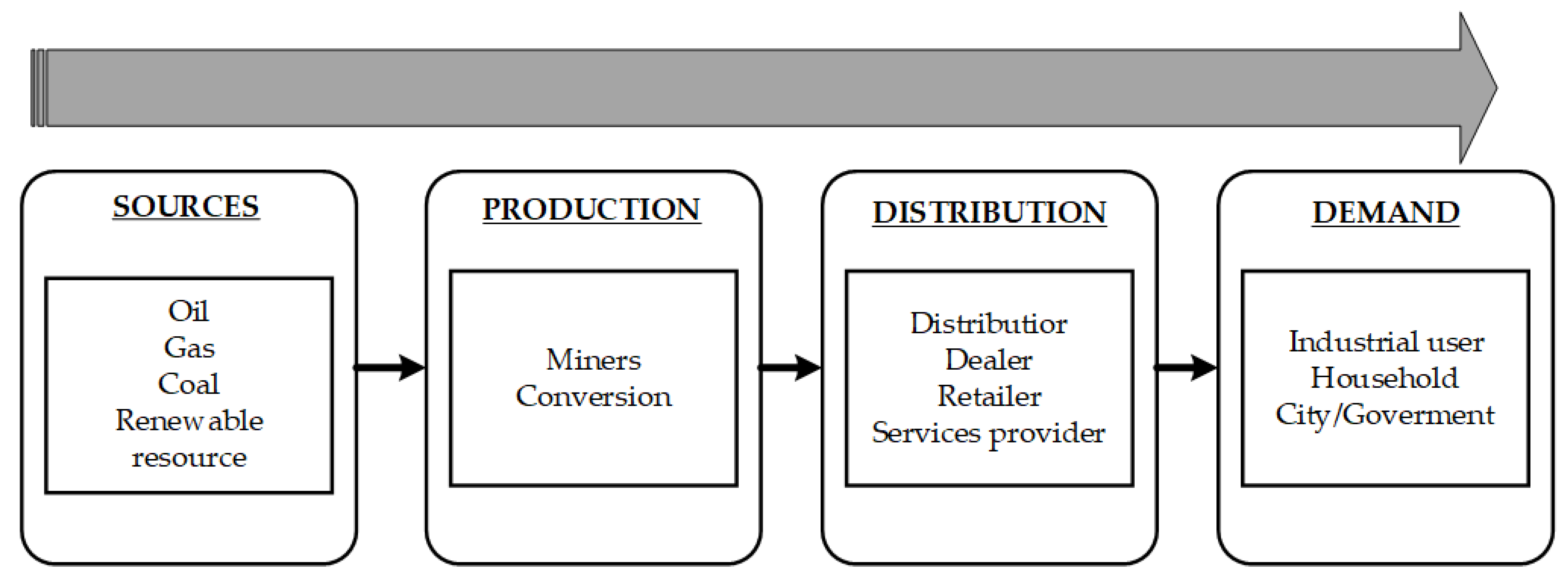


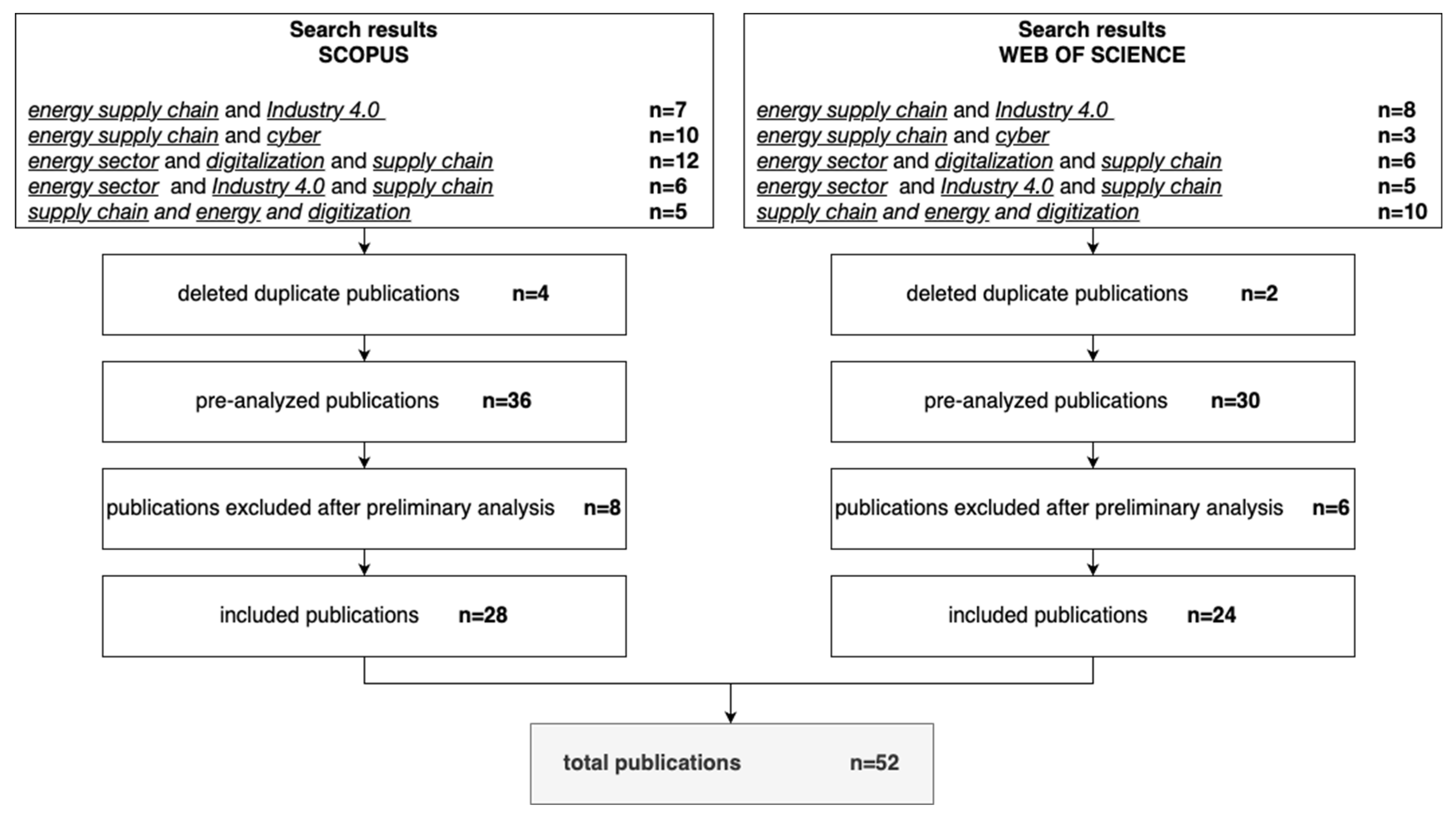
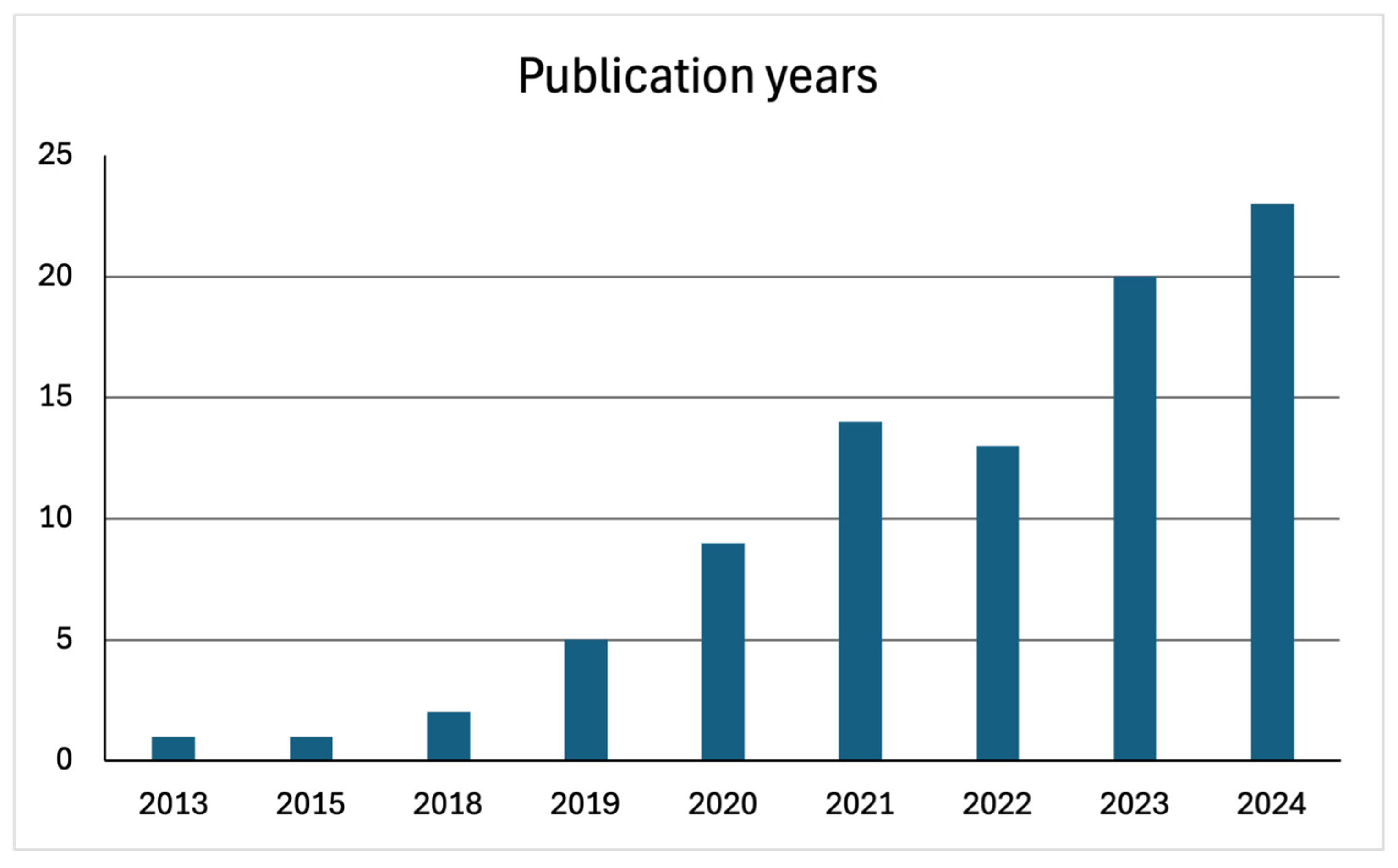

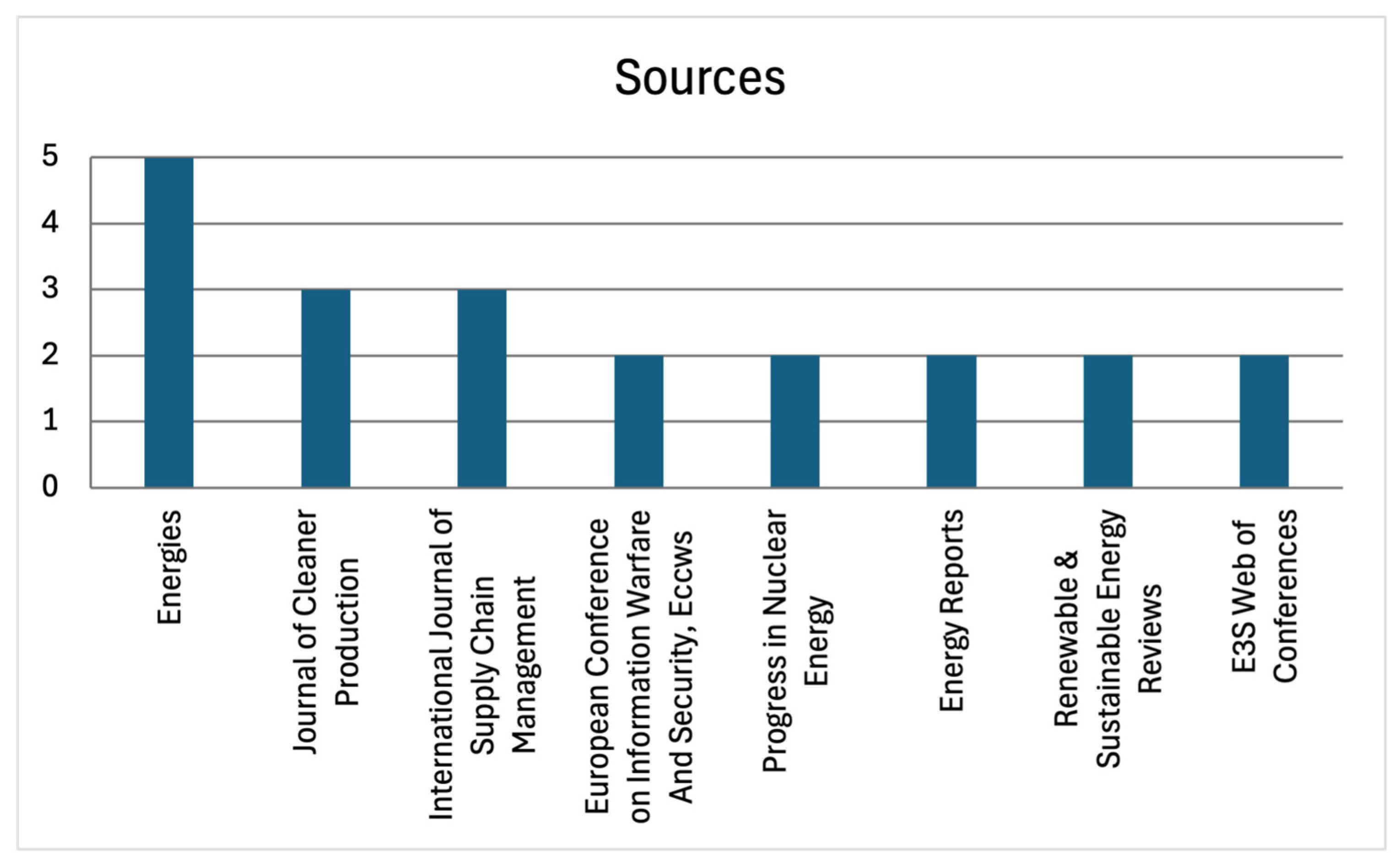
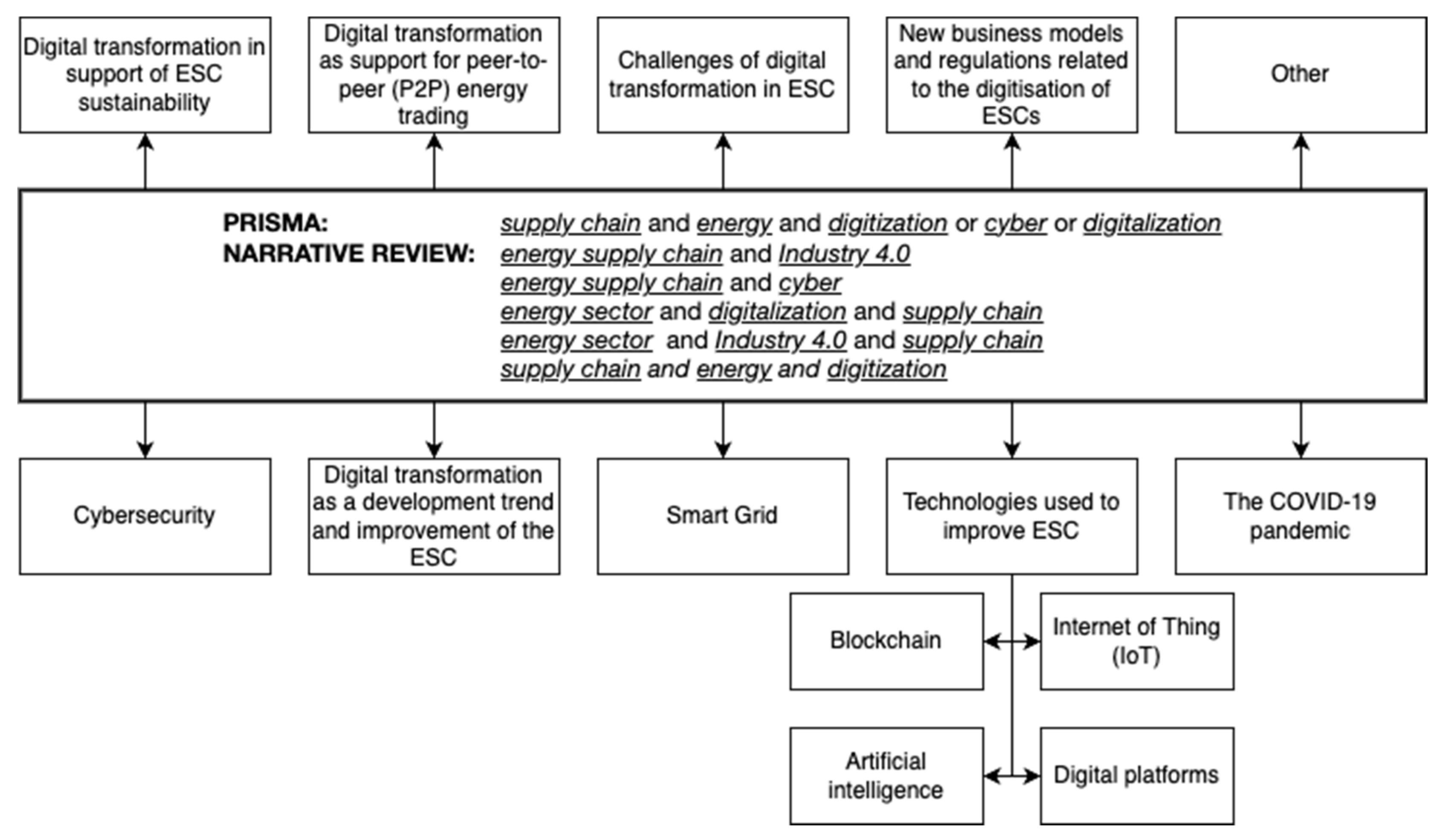

| Source | Characteristics |
|---|---|
| Biomass energy |
|
| Hydropower and wave energy |
|
| Geothermal energy |
|
| Wind energy |
|
| Solar energy |
|
| IDENTIFICATION OF RISKS | [22,25,26,29,30,35] |
| |
| BUILDING CYBERSECURITY | [22,27,28,29,31,32,33,36,37,38,39] |
| |
| CYBERSECURITY | [22,28] |
| |
| SMART GRID DEVELOPMENT | [56,57,58] |
| |
| PEOPLE | [86,87,89] |
| |
| PROCESSES | [86,89] |
| |
| TECHNOLOGY | [86,88,89] |
| |
| MATERIALS | [88,90] |
| |
| FINANCES | [88] |
| |
Disclaimer/Publisher’s Note: The statements, opinions and data contained in all publications are solely those of the individual author(s) and contributor(s) and not of MDPI and/or the editor(s). MDPI and/or the editor(s) disclaim responsibility for any injury to people or property resulting from any ideas, methods, instructions or products referred to in the content. |
© 2025 by the authors. Licensee MDPI, Basel, Switzerland. This article is an open access article distributed under the terms and conditions of the Creative Commons Attribution (CC BY) license (https://creativecommons.org/licenses/by/4.0/).
Share and Cite
Tubis, A.A.; Poturaj, H. Energy Supply Chains in the Digital Age: A Review of Current Research and Trends. Energies 2025, 18, 430. https://doi.org/10.3390/en18020430
Tubis AA, Poturaj H. Energy Supply Chains in the Digital Age: A Review of Current Research and Trends. Energies. 2025; 18(2):430. https://doi.org/10.3390/en18020430
Chicago/Turabian StyleTubis, Agnieszka A., and Honorata Poturaj. 2025. "Energy Supply Chains in the Digital Age: A Review of Current Research and Trends" Energies 18, no. 2: 430. https://doi.org/10.3390/en18020430
APA StyleTubis, A. A., & Poturaj, H. (2025). Energy Supply Chains in the Digital Age: A Review of Current Research and Trends. Energies, 18(2), 430. https://doi.org/10.3390/en18020430







